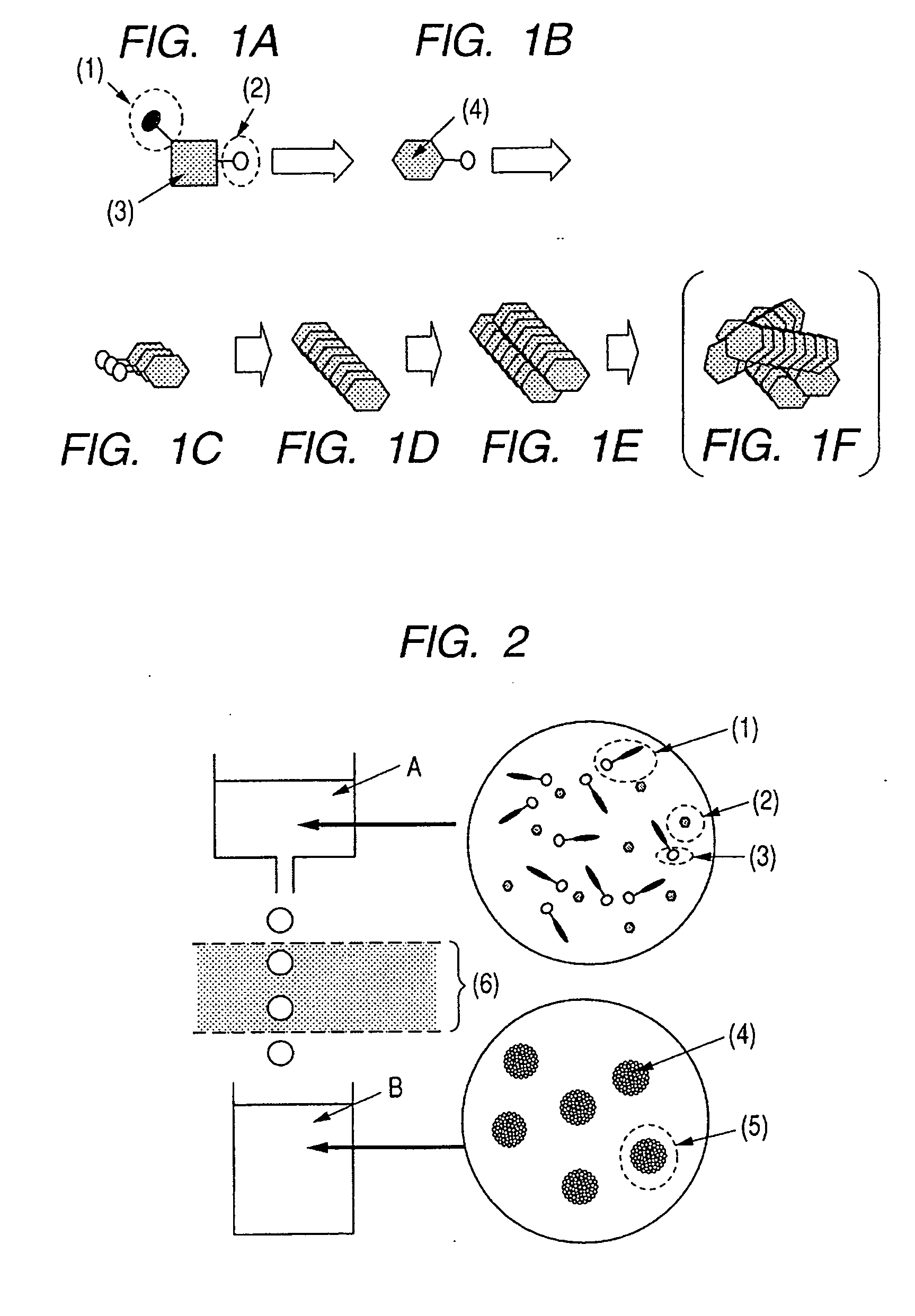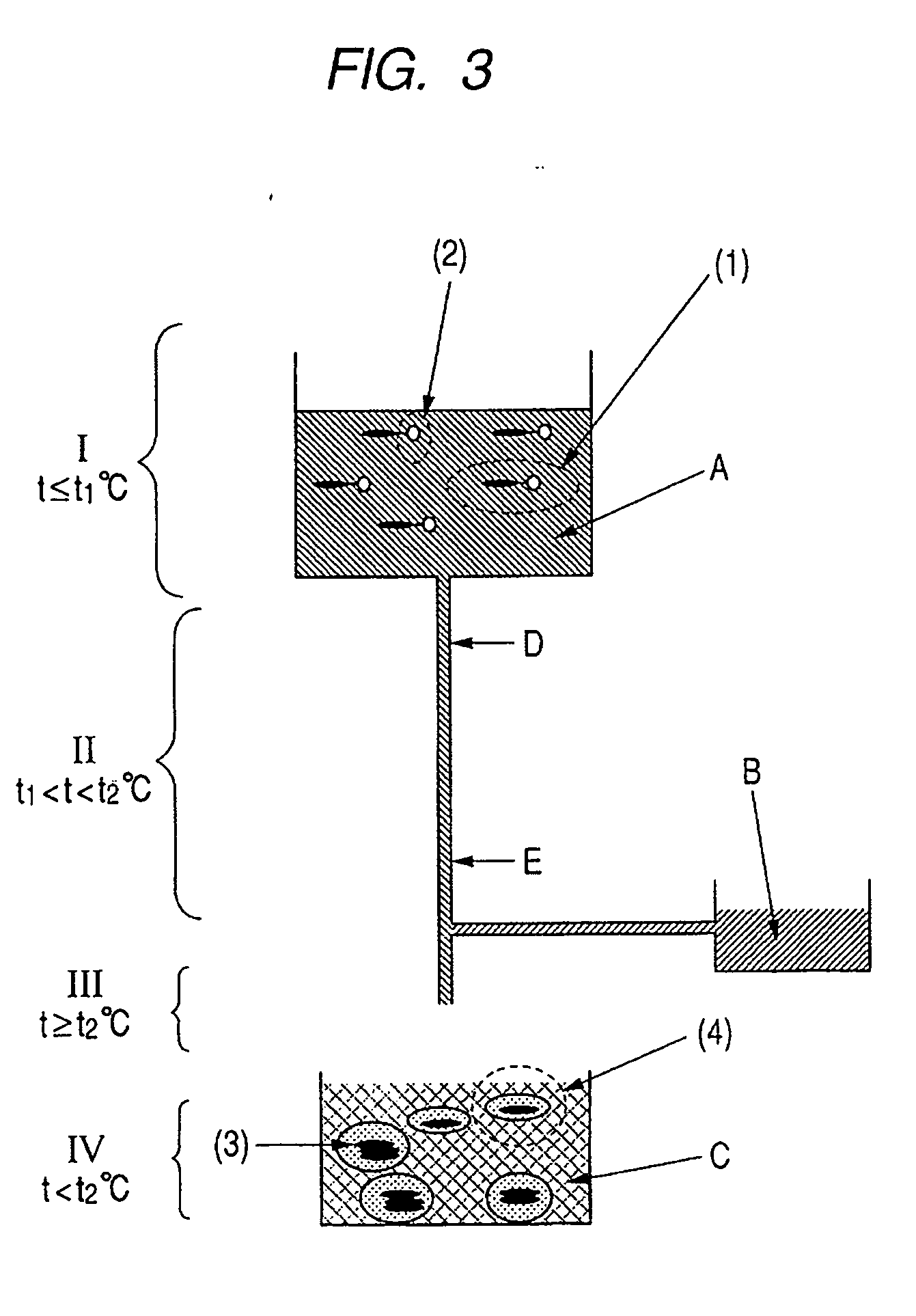Pigment, process for producing pigment, pigment dispersion, process for producing pigment dispersion, recording ink, recording method, and recorded image
a pigment and process technology, applied in the field of pigments, can solve the problems of difficult to obtain pigments consisting of narrow particle size distribution and primary particles using mechanical crushing, particle size distribution, and destruction of primary particles, and achieve stable discharge, improve storage stability, and satisfy the effect of stability over tim
- Summary
- Abstract
- Description
- Claims
- Application Information
AI Technical Summary
Benefits of technology
Problems solved by technology
Method used
Image
Examples
example 1
[0148] The tetraazaporphyrin pigment monomolecule precursor prepared in Exemplary synthesis 1 was dissolved in diethylene glycol monobutyl ether to make a 30% solution. This solution was dripped in a 200° C. atmosphere to prepare a colored pigment of tetraazaporphyrin that is substantially of a primary particle maintaining type. This colored pigment was measured with X-ray diffraction (XRD) using CuXα ray to confirm the formation of the colored pigment as a result of the transformation of the pigment monomolecule precursor into pigment monomolecules by the retro Diels-Alder reaction.
example 2
[0149] First, using benzyl methacrylate and methacrylic acid as raw materials, an AB type block polymer of an acid value of 250 and a number-average molecular weight of 3,000 was prepared by conventional methods, neutralized with potassium hydroxide solution, and diluted in ion-exchange water to give a homogeneous 50% polymer aqueous solution. The tetraazaporphyrin monomolecular precursor prepared in Exemplary synthesis 1 above was dissolved in diethylene glycol monobutyl ether to make a 30% solution. 320 g of the 30% tetraazaporphyrin monomolecule precursor solution and 180 g of the polymer solution prepared above were mixed. This mixed solution was dripped into the aqueous solution so as to pass through a 200° C. atmosphere to prepare a colored pigment dispersion.
[0150] This pigment dispersion was measured with X-ray diffraction (XRD) using CuXα ray to confirm the transformation of the pigment monomolecule precursor into pigment monomolecules by the retro Diels-Alder reaction. Th...
example 3
[0151] First, using benzyl methacrylate and methacrylic acid as raw materials, an AB type block polymer of an acid value of 250 and a number-average molecular weight of 3,000 was prepared by conventional methods, neutralized with potassium hydroxide solution, and diluted in ion-exchange water to give a homogeneous 50% polymer aqueous solution. The tetraazaporphyrin monomolecule precursor prepared in Exemplary synthesis 1 above was dissolved in 1,6hexanediol previously liquefied by heating to make a 30% solution. 320 g of the 30% tetraazaporphyrin monomolecular precursor solution and 180 g of the polymer solution prepared above were mixed. This mixed solution was dripped into the aqueous solution so as to pass through a 200° C. atmosphere to prepare a colored pigment dispersion.
[0152] This pigment dispersion was measured with X-ray diffraction (XRD) using CuXα ray to confirm the transformation of the precursor of the pigment monomolecule (molecules constituting a colored pigment tha...
PUM
| Property | Measurement | Unit |
|---|---|---|
| Molecular structure | aaaaa | aaaaa |
Abstract
Description
Claims
Application Information
 Login to View More
Login to View More - R&D
- Intellectual Property
- Life Sciences
- Materials
- Tech Scout
- Unparalleled Data Quality
- Higher Quality Content
- 60% Fewer Hallucinations
Browse by: Latest US Patents, China's latest patents, Technical Efficacy Thesaurus, Application Domain, Technology Topic, Popular Technical Reports.
© 2025 PatSnap. All rights reserved.Legal|Privacy policy|Modern Slavery Act Transparency Statement|Sitemap|About US| Contact US: help@patsnap.com



